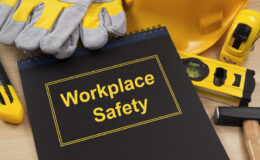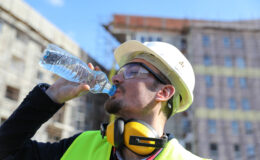By Ruth Kiefer, MSc, ARM
Vice President of Loss Control
As many of you have already experienced, MIOSHA had a full complete year of compliance audits and are on a roll. To help our policyholders stay on track, we always try to provide CET’s annual release of the top 20 that they provide at their annual Michigan Safety Conference. On the General Industry Safety violation side, approximately 500 citations were issued in 2023. They collected $1.33 Million in fines, which averages out to $2,606 for the average safety citation. Now for the Health side of things, as there are always two parts. The Health side issued 565 citations and collected $823,200 in fines. The average citation per location was $1,456. If you are unsure if you have a Health or Safety violation, please contact your Loss Control Consultant for more guidance of these most cited violations below. We are happy to help you stay in compliance.
GENERAL INDUSTRY: MOST COMMON SAFETY CITATIONS
Part 26. Metalworking Machinery: Rule 2635(1): Vertical band saw shall be guarded as follows: (a) “other than point-of-operation and (b) At the point of operation. Average citation: $1,577
Part 1: General Provisions. Rule 34(3) Point of operation guard. Guard the machine operator against all hazards/hazardous area during operating cycle. Average citation: $2,600
Part 1: General Provisions. Rule 408.10034(9) Pinch Points. When an employee is exposed to a hazard created by a pinch point other than point of operation, the hazard shall be guarded or the employee otherwise protected. Average citation: $3,793 This includes your overhead doors. All powered overhead and sliding doors must be equipped with either a sensing strip, photoelectric eye, constant pressure down control switch or a slip clutch device.
Part 92. Hazard Communication. Rule 1910.1200(e) Written Hazard Communication Program. (1) Employers shall develop, implement, and maintain at each workplace, a written hazard communication program which at least describes how the criteria specified in paragraphs (f), (g), and (h) of this section for labels and other forms of warning, safety data sheets, and employee information and training will be met. Average citation: $5,218
Part 2. Walking Working Surfaces. Rule 1910.28(b)(1)(I). Unprotected sides and edges. The employer must ensure that each employee on a walking-working surface with an unprotected side or edge that is 4 feet or more above a lower level is protected from falling by one or more of the following: (A) guard rail system, (B) Safety net system or (C) Personal fall protection systems, such as personal fall arrest, travel restraint, or positioning systems. Average citation: $5,218
Part 7. Guards for Power Transmission. Rule 408.10727(1) Belts. (1) A belt and pulley that is 7 feet or less above the floor or platform and that is exposed to contact must be guarded. Average citation: $2,359
Part 33. Personal Protective Equipment (PPE). Rule 408.13308 Personal Protective Equipment hazard assessment and equipment selection. (1) An employer shall assess the workplace to determine if hazards are present, or likely to be present, that necessitate the use of personal protective equipment. Average citation: $1,791
Part 85. The Control of Hazardous Energy Sources. Rule 1910.147(c)(6) Periodic Inspection. Conduct a periodic inspection of the energy control procedure at least annually. Average citation $1,308
Part 85. The Control of Hazardous Energy Sources. Rule 1910.147(c)(7)(I)(A) Authorized Employee. Each authorized employee shall receive training in the recognition of applicable hazardous energy sources, the eyes and magnitude of energy available in the workplace, and the methods and means necessary for energy isolation and control. Average citation: $1,195
Part 85. The Control of Hazardous Energy Sources. Rule 1910.147(c)(4)(I). Energy Control Procedure. Procedures shall be developed, documented and utilized for the control of potentially hazardous energy when employees are engaged in the activities covered by this section. Average citation: $4,968
GENERAL INDUSTRY: MOST CITED HEALTH VIOLATIONS
Part 301. Air Contaminants. 325.51103(a)(iii). Exposure Limits. Not conducting air sampling when there is a TWA or STEL of the chemical you are working with. Average citation: $6,191
Part 92. Hazard Communication. Workplace Labeling. The employer shall ensure that each container of hazardous chemicals in the workplace be labeled, tagged or marked with either: the product identifier and words, pictures, symbols, or a combination thereof which provided at least the general information regarding the hazards of the chemical.
Part 92. Hazard Communication. Information and Training Requirement. Employers must train on the new Global Harmonization System of Classification and labeling of chemicals. They must be able to read the new SDS’s. Average citation: $760
Part92. Hazard Communication. 1910.1200(e)(1). Employers shall develop, implement, and maintain at each workplace, a written hazard communication program which at least describes how the criteria specified in paragraphs (f), (g), and (h) of this section for labels and other forms of warning, safety data sheets, and employee information and training will be met. Average citation: $1,159
Part 430. Hazard Communication. 1910.1200(h)(3). Employee training shall include at least: methods and observations that may be used to detect the presence or release of hazardous chemicals in the work area, physical, health simple asphyxiation, combustible dust and pyrophoric gas hazards, as well as hazards not otherwise classified and measures the employee can take to protect themselves from the hazard. Average citation: $1,476
Part 472. Medical Services and First Aid. 325.47201(3). Eyewash and Quick Drenching Requirement. An employer shall ensure that suitable facilities for quick drenching or flushing of eyes and body are provided within the work area for immediate emergency use when the eyes or body of any person may be exposed to injurious corrosive materials.
Part 451. Respiratory Protection. 1910.134(c)(1). A written Program is required as part of this standard. Average citation. $1,816
Part 451. Respiratory Protection. 1910.134(f)(2). Fit Testing. You must fit test respirators prior to their use for all tight fitting or required respirators, whenever a different respirator face-piece is used, or at least annually. Average citation: $2,557
Part 451. Respiratory Protection. 1910.134(c)(2). An employer may provide respirators at the request of the employees or permit employees to use their own respirators, if the employer determines that the respirator will not in itself create a hazard. Provide information in Appendix D to all comfort respirator users. Must have a written program. Average citation: $1,692
Part 451. Respiratory Protection. 1910.134(e)(1). A medical evaluation must be completed for employees that are required to wear a respirator. Average citation: $428






